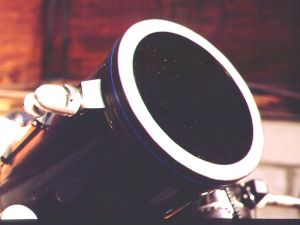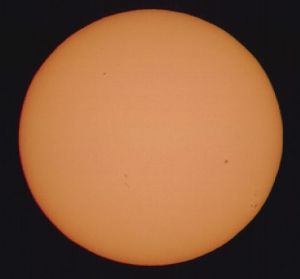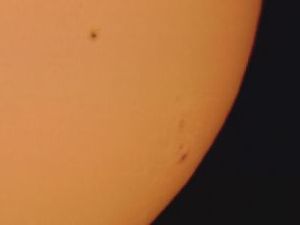



Starlight MX5C
Olympus ES-10
slide scanner
Vixen GP Mount
Meade's LX6
Ultima 9.25
Telrad
Starlight Xpress SX
Flip Mirror (TTL)
Meade's LX200
Starcharts
Sky Commander |
|
|

Orion (USA) Solar Filter
Introduction
With the UK's first total solar eclise in decades this August, I decided
that now was as good a time as any to buy a full aperture solar filter for
my 10" SCT. I had previously used another brand of filter that had taken
months to arrive from the USA, so when I saw one of these Orion filters at
European Astrofest for 120 pounds sterling, I just couldn't resist buying
it. This type of filter is ideal for showing sun spots and various
phenomina associated with spots. If you use one of these filters don't forget
to remove your Telrad and cover your finder scope, otherwise they might suffer
damage. This type of filter is ideal for showing sun spots and various
phenomina associated with spots. If you use one of these filters don't forget
to remove your Telrad and cover your finder scope, otherwise they might suffer
damage.
The filter consists of a coated glass filter in a matt black aluminium holder.
The holder is lined with a dense sponge rubber, of a similar material
to a diver's wet suit. This rubber forms a friction fit with the SCT's corrector
plate holder. I really don't know why Orion couldn't have included three
nylon bolts to secure the filter to the telescope using the neat groove around
the front of the telescope for that purpose. I have visions of pointing the
telescope slightly downwards and hearing a crash as the filter hits the floor!
Maybe some of these filters are a tighter fit than mine, even with all the
extra sponge strips provided, mine isn't exactly a tight fit.
 Some earlier filters used an aluminium coating, similar to the
cheap Mylar filters often seen at eclipse sites. This filter uses a stainless
steel coating to give a 'natural' orange/yellow colour to the sun's disk.
Mylar filters generally give a blue coloured sun which looks anything but
natural. The instructions for this filter didn't state if it was intended
primarily for 'photographic' or 'visual' use (some other makers
have specific filters for each use). Used with 50asa slide film at f6.3 the
exposure reading on my Canon A1 camera was 1/90th of a second, dropping to
around 1/20th when eyepiece projecting with a 20mm eyepiece. The images shown
are the sun's full disk at f6.3 and approximately 1/4 of the sun via eyepiece
projection. North is uppermost in these images. The slides are Ektachrome
50 slide film developed in a Photocolor Chrome 6 kit. The slides were scanned
with an Olympus ES-10 scanner. Some earlier filters used an aluminium coating, similar to the
cheap Mylar filters often seen at eclipse sites. This filter uses a stainless
steel coating to give a 'natural' orange/yellow colour to the sun's disk.
Mylar filters generally give a blue coloured sun which looks anything but
natural. The instructions for this filter didn't state if it was intended
primarily for 'photographic' or 'visual' use (some other makers
have specific filters for each use). Used with 50asa slide film at f6.3 the
exposure reading on my Canon A1 camera was 1/90th of a second, dropping to
around 1/20th when eyepiece projecting with a 20mm eyepiece. The images shown
are the sun's full disk at f6.3 and approximately 1/4 of the sun via eyepiece
projection. North is uppermost in these images. The slides are Ektachrome
50 slide film developed in a Photocolor Chrome 6 kit. The slides were scanned
with an Olympus ES-10 scanner.

Jump to top of page



|
